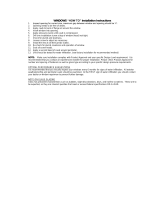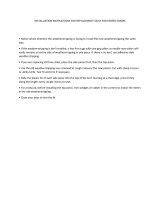Page is loading ...

WEST REGION REPLACEMENT WINDOW INSTALLATION INSTRUCTIONS
CAUTION: Some areas that are designated as high
wind or windborne debris areas may require additional
or special anchorage in order to comply with local and
state building codes. Please consult your local Code
Official for certified instructions regarding the installa-
tion of this product.
Read all instructions thoroughly before beginning
the installation of the window. These instructions are
intended as a basic guide for installing replacement
windows. If you require more in-depth instructions,
that cover a specific window or door style or installing
windows in a new construction application, please
contact your Simonton Distributor or visit simonton.
com for current installation instructions.
1 a. Before removing old unit inspect new unit for correct
size, type, damage an correct installation information
for your application. If a problem exists with any of
these areas contact your distributor before installing.
b. Begin by measuring the window to be replaced.
Measure at three locations: top, middle and bottom of
the window on width, and right, center and left on
height. Use the smallest of these measurements to
determine the width and height. Do not remove the
old window until the dimensions of the new window
have been verified to fit the opening properly and you
have all the accessories needed.
c. Check opening for square by measuring diagonally. If
unit is out of square additional cut backs may be
required.
Accessories are available from Simonton to ease the instal-
lation and finishing of the new window. For more informa-
tion on accessories and their applications, contact your
Simonton Distributor.
2 If local codes permit the removal of the existing window
uding the frame), the proper installation procedures
according to AAMA standards must be followed to pre-
vent future leaking problems. Remove the old window
and prepare the opening (leveling off the sill if necessary).
It is important to remember that the replacement
window must fit into the opening plumb, level and
square, even though the opening may not be any of
these. If the window is not plumb, level and square the
following problems may occur:
• Hung and Slider sash may be difficult or impossible
to remove.
• Casement sash may not operate properly due to
excessive drag on the sill.
• The overlapping and interlocking meeting rail on Hung
and Slider windows may not perform properly - allow-
ing air and water infiltration, even if the sash is locked.
• The weatherstripping may not seal properly, allowing
air and water infiltration.
• The locking system may not engage properly.
3 When installing in a slope sill application, place wood
blocks along the existing windowsill. The blocks will
help support the window and keep the sill level. Also,
wrap the entire perimeter of the window with insulation.
If gaps between the unit and the opening are less than
¹⁄8 the unit may not require insulation. When this occurs
Simonton recommends an exterior and interior perime-
ter seal to create a dead air space.
4 Attach the sill extender (if necessary) to the bottom of
the sill and trim it to fit in the opening. Be careful not to
cut the sill extender too tight to prevent deflection of
sill. Sill extender should not be used as support.
5 Tilt the window up into the opening with the sash
closed and locked. Set it down on the wood blocks
placed along the windowsill.
6 If supplied, tighten the adjustment devices
(alignment clips, jamb adjusters, etc.) and shim
the wood blocks to hold the unit secure while
checking it for plumb, level, and square. Be
careful not to over tighten jamb adjusters to
avoid twisting or deflection of jambs. If your
windows do not have jamb adjusters then
you will have to supply your own shims.
• To check plumb: Place a level vertically on
both the interior and face of the left and right
jambs. If the bubble indicator is centered, the
unit is plumb
(Fig. A).
• To check level: Place a level along the sill. If
the bubble indicator is centered, the unit is
level (Fig. B).
• To check square: Measure from the top left corner of
the frame to the bottom right corner and from the top
right to bottom left. If the measurements are equal,
the window is square (Fig. C). You can also check the
squareness by closing the sash to the point where it
just meets the head or sill. If both sides of the sash
meet the head or sill at the same time, the window is
square.
7 Check the sash where they meet the frame to be cer-
tain the weatherstripping is sealing properly in all areas.
Inspect all weatherstripping to insure it has not pulled
out of the receiver channel. To reinstall it, pull the strip-
ping completely out of the channel then reinsert it by
sliding the spline into the receiver channel. Check for
an even reveal (gap) between the sash and the frame.
Fig. A
Fig. B
Fig. C

8 Once the window is plumb, level and square, install
installation screws into the prefabricated installation
holes in the jambs. Shims should be used to establish
spacing at anchoring points and should be penetrated
by the installation screw. DO NOT OVER TIGHTEN
THE SCREWS, as this could cause the frame to bow.
Recheck the sash for proper operation once the
screws have been installed. Caulk and cover the instal-
lation holes when necessary. If the windows do not
have prefabricated holes, pre-drilling and countersink-
ing the screws will be required. Cover the hole with the
appropriate sized plug button. Buttons can be
obtained from your dealer or supplier.
Note: When installing Casements, place screws in the
installation holes. Prior to placing the #10 x 2 ½" screw in
the sill, drill two holes in the uppermost level of the sill with
a stepdrill. Holes should be 3 from each interior corner and
½" from the innermost surface of the frame tower. The drill
bit should be ³⁄16 in diameter, with the step being ³⁄8 in
diameter. Drill straight down (Fig. D) until the step just
breaks the first layer of the vinyl. A separate layer of vinyl
should be visible which is where the head of the screw will
rest. Install the screws into the holes so that the head of
the screw rests on the inner chamber. Seal the head of the
screw with an approved sealant and cap the hole with a
plug button to be sure the holes remain watertight.
Replace a screw in each tie bar guide with installation
screws (Fig. E). After the window is secured, recheck the
sash operation and the weather seals. With Awning win-
dows, install installation screws in the head and sill as
described in the Casement procedures (Fig. D). Replace
one of the center screws in the operator assembly with an
installation screw (Fig. F).
Replace the second screw from the top and the closest
screw to the bottom on the hinge tracks with installation
screws (Fig. G). After the window is secure, recheck the
sash operation and weather seals.
9 If installing large windows or win dows with high wind
load requirements, install interior and exterior blind
stops along the jambs, head and sill (if not already
present). The blind stops must be a minimum of ¾
by ½.
10 If installing a window with a stucco flange, follow the
preceding instructions. Before placing the window into
the opening for the final time after making sure it will
be plumb, level and square, place a heavy layer of
caulking along the interior of stucco flange approxi-
mately ½" from the bottom edge. Leave two small
gaps in the caulking at either end of the bottom edge
of the stucco flange.
11 Finish off the exterior of the window. Seal the entire
perimeter of the window with the proper grade of seal-
ant. Trim and cap off where necessary. Do not cover
weeps. Use of expanding foam is acceptable as long
as it meets AAMA 812 specifications.
12 Make certain sash open, close and lock properly.
Operable slider sash should lift out freely. Finish off
the interior of the window.
13 Remember: The homeowner is the final inspector.
Clean the window well and remove all debris from the
job site. Be sure the homeowner is familiar with the
proper operation and all the features of the window.
Make sure you have supplied the homeowner with
the proper warranty card, as this will explain proper
cleaning and operating function of the window.
Fig. G
Fig. D
Fig. F
Fig. E
Fig. H
WEST REGION REPLACEMENT WINDOW INSTALLATION INSTRUCTIONS
Revised 09/12
/




